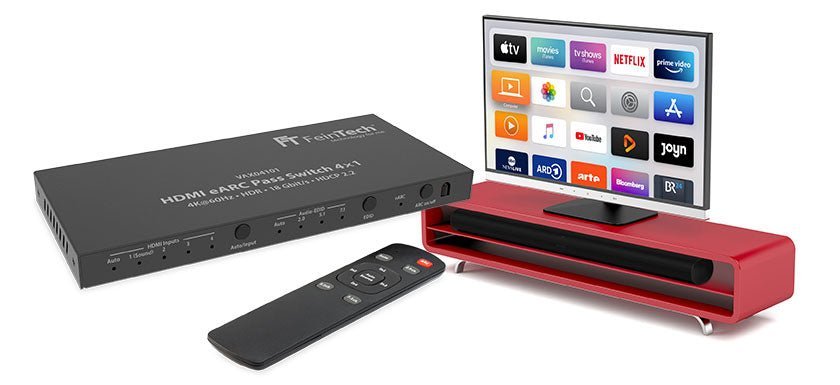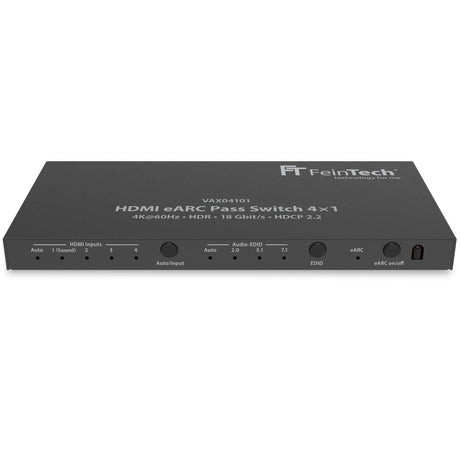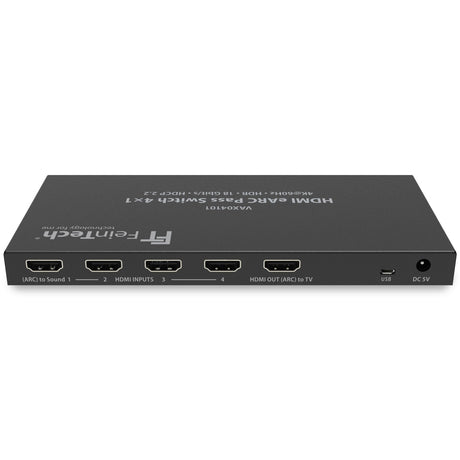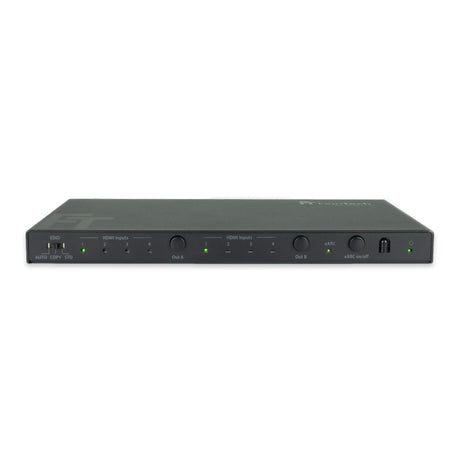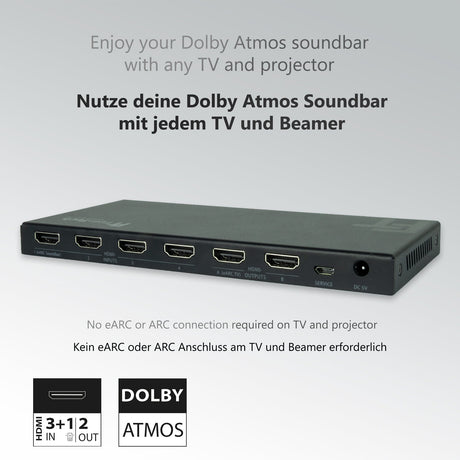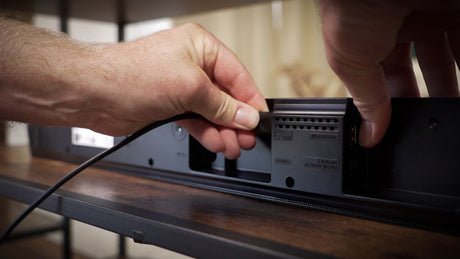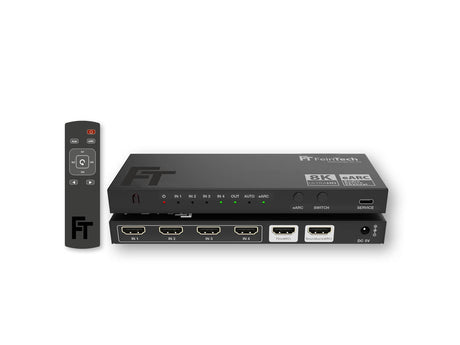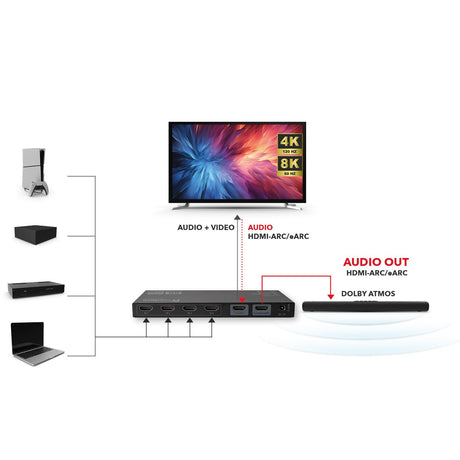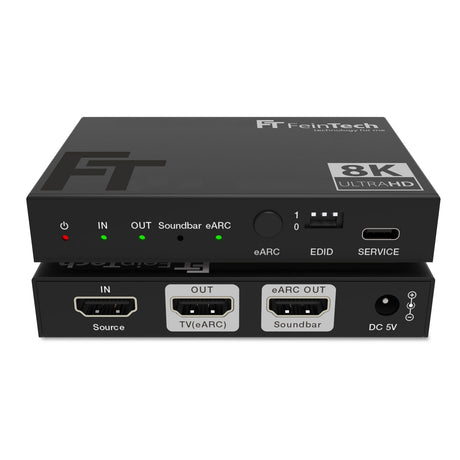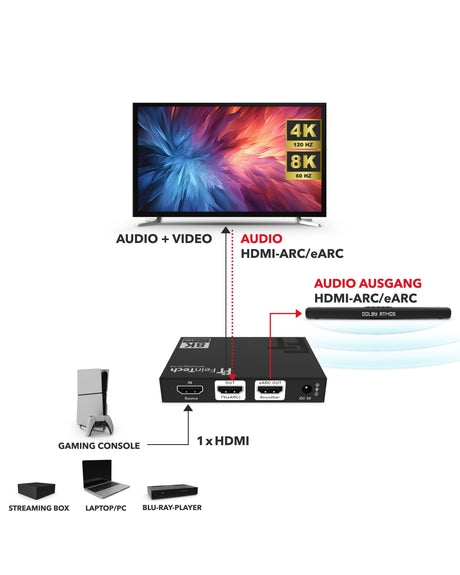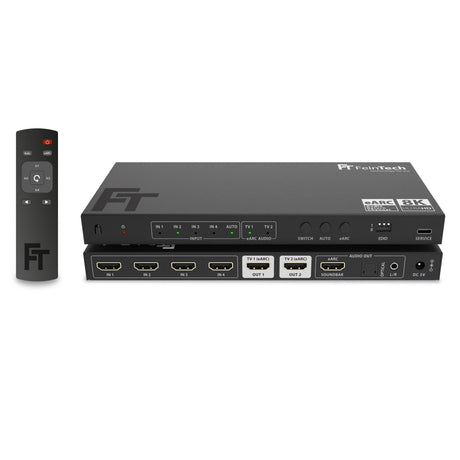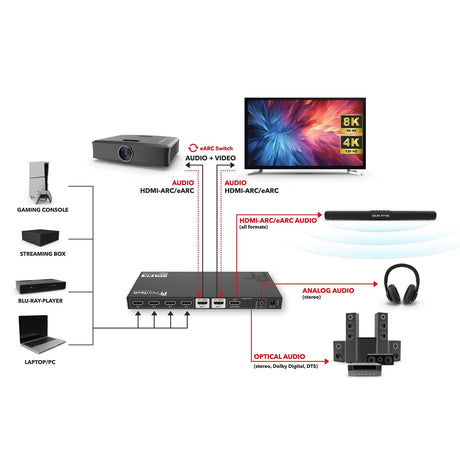This new HDMI switch was developed to connect a soundbar with HDMI-eARC port to your HDMI sources - independent from the function of the TV or video projector. That doesn't work with a usual splitter. Because the HDMI-ARC or eARC connection of the soundbar is an HDMI output , no HDMI input. But the sound is transmitted in the opposite direction via the audio return channel.
The HDMI-ARC interface has been on TVs for a long time. This allows the TV sound to be played back via an HDMI input on the television to the output of an AV receiver or a soundbar. Note the signal direction: the sound is transmitted from the TV input to an HDMI output, i.e. in the opposite direction to the audio-video signal. ARC was originally limited to Stereo, Dolby Digital and DTS audio formats. For a number of years, LG and Samsung televisions have also been able to output Dolby Digital Plus via ARC. This also makes Dolby Atmos from streaming services possible. But no higher audio formats.
The HDMI-eARC interface has been available since 2020 and works in the same way in principle. eARC stands for Enhanced Audio Return Channel, i.e. the improved version. eARC makes it possible to transmit additional audio formats such as Dolby TrueHD or DTS-HD.
HDMI-ARC/eARC is not only used on TVs to transmit the internal sound (cable TV, satellite TV or smart TV) to the soundbar. But also for external sources such as PCs or media players that are connected to the TV. The wiring effort is therefore low. Unfortunately, there are possible limitations. And here the VAX04101 switch helps:
-
Better audio formats:
The TV often does not support better audio formats. DTS sound, Dolby True-HD or Dolby Atmos are not forwarded by many televisions. The VAX04101 fixes that by bypassing the TV's limitations. -
No Audio Delay:
Or the sound is only sent after the video processing and is therefore too late at the sound system. Sound is no longer lip-synced. The VAX04101 prevents such a delay, because sound no longer depends on the television when playing from external media players. -
Soundbar can be operated with a projector or monitor:
Video projectors or monitors do not have an HDMI ARC or eARC connection. They cannot be used with soundbars that require HDMI-ARC. With the VAX04101 it works flawlessly.

Functionality
The VAX04101 delivers audio and video signals from an HDMI source to the HDMI sink (TV, monitor or video projector). HDMI data rates of up to 18 Gbps are supported. 4K 60Hz and HDR formats such as Dolby Vision are therefore possible. On the front of the device, the so-called EDID mode is set. This defines the maximum possible audio format – usually that of the soundbar. If a powerful sound system is connected, "7.1" should be set here. This signals to the player that all audio formats up to 7.1 sound are supported. If the soundbar does not support Dolby Atmos, DTS-HD or Dolby TrueHD, "5.1" should be set. The "Auto" position only corresponds to the maximum audio format of the TV.
Please note: Some soundbars support the high audio formats Dolby Atmos and Dolby TrueHD, but not the competing formats of DTS (DTS-X and DTS-HD Masteraudio). DTS formats are often found on Blu-ray discs. But there are no streaming videos with DTS sound. If the soundbar remains silent when playing a Blu-Ray, it is best to change the audio track manually. The Sonos soundbars support DTS but no DTS-HD, so please select an appropriate audio track.
In addition media player often offer a selection or setting option for the audio format. This overturns the automatic format negotiation. In this way, the output can be adjusted even better.
Everyday use
The desired HDMI source on the VAX04101 is selected using the remote control or the front panel button. The soundbar is connected to HDMI input 1. So if you switch to input 1, the on-screen menu of the soundbar (if available) appears on the screen. If the soundbar has another HDMI connection, an additional player can be connected there.
The sound from the selected source is routed to the soundbar. The television receives the video signal from the source. In most cases the TV speakers will remain silent because ARC is enabled or the audio format is not supported. In principle, however, it is possible for the television to also receive the sound. The same audio format is used as on the soundbar. Therefore, TV headphones may remain silent because the TV does not convert the format. That depends on their skills.
If a TV is connected with its HDMI-ARC port, the TV sound can also be heard via the soundbar and the VAX04101. To do this, please switch the TV to the receiver or the smart TV app. Then select HDMI input 1 on the VAX04101.
Limited automatic switching
In principle, with an HDMI switch, switching can take place via hotplug detection ( pin 19 ). Many devices only give a signal here when they are connected – not when they are switched on or off. A fully automatic switching of all inputs therefore often does not work. Devices without a power switch such as Apple TV, Fire TV or Chromecast in particular prevent automatic switching.
Because a television monitors its HDMI inputs and the players connected via HDMI handshake. As soon as a switch-on command is sent here, the television can switch to the respective HDMI input. A switch is transparent, the connection between the HDMI source and the television also takes place here. However, the TV or switch does not receive any control command from the inactive HDMI inputs. Because there is no connection to them.
If several HDMI sources are connected and one of them does not have a power switch, it must be switched over manually. Switching is possible on the VAX04101 with a button or with the infrared remote control. A programmable remote control can also be set up accordingly.
HDMI CEC control
Via HDMI CEC the player selected on the switch communicates with the television. Therefore, the TV remote can control the media player. When the television or media player is switched off, the connected device is also switched off if it supports this function. However, players on the inactive outputs cannot be controlled via CEC. Because there is no active connection.
Alternative use
The VAX04101 can also be used like a conventional HDMI switch 4×1. 4 HDMI sources can then be operated on one HDMI sink (television, video projector or sound system with a real HDMI input). To do this, switch off "eARC" on the switch.
Notes for users of the Sonos app
The Sonos App S2 enables the integration of additional audio services such as Internet radio, Spotify, Amazon Music etc. However, this app requires connection to a TV with ARC (or optical adapter). The app checks the connection when installing or troubleshooting starts. However, if a Sonos soundbar is connected to the VAX04101 instead of a TV, the app will report an error when you check the connection there. It suggests to reinstall which makes no sense in this use case. This is very annoying. We therefore recommend not starting the installation dialog. It is not necessary, you connect and switch on. When sound comes through the soundbar, the app can be used as intended. All functions and settings such as sound, volume, audio delay of the S2 app work as usual.
Update via USB
The VAX04101 is now equipped with a USB-micro connection, via which updates can be installed via a Windows PC if required. The update is in this operation manual described. Update, firmware and software are available here to download .
Technical specifications:
| signal input | 4 × HDMI (including 1× HDMI-eARC for soundbar) |
| Supported copy protection | HDCP 1.x, HDCP 2.2 |
| data transfer rate | maximum 18 Gbps |
| Supported video formats | up to 2160p@60Hz, 1080p/1440p@120Hz |
| signal outputs | 1 × HDMI, 1 × HDMI eARC |
| color space | RGB, YCbCr 4:4:4, 4:2:2; 4:2:0 |
| Supported color depth | 3 × 8 bits / 10 bits / 12 bits |
| HDR (High Dynamic Range) | HDR10, HDR10+, HLG, Dolby Vision |
| EDID modes | 2.0 | 5.1 | 7.1 | Auto (equivalent to HDMI TV output) |
| Audio formats HDMI | DTS-HD (incl. DTS-X), Dolby True-HD (incl. Atmos), Dolby Digital Plus, AC3 (Dolby Digital 5.1), DTS, DTS-EX, DSD, LPCM 2.0 – 7.1, Dolby MAT |
| HDMI CEC control | Yes |
| Recommended HDMI cable lengths | < 3 m at the entrance, < 3m at TV output (at 4K 60Hz) |
| power consumption | < 2W |
| Dimensions | 183×85×19mm |

